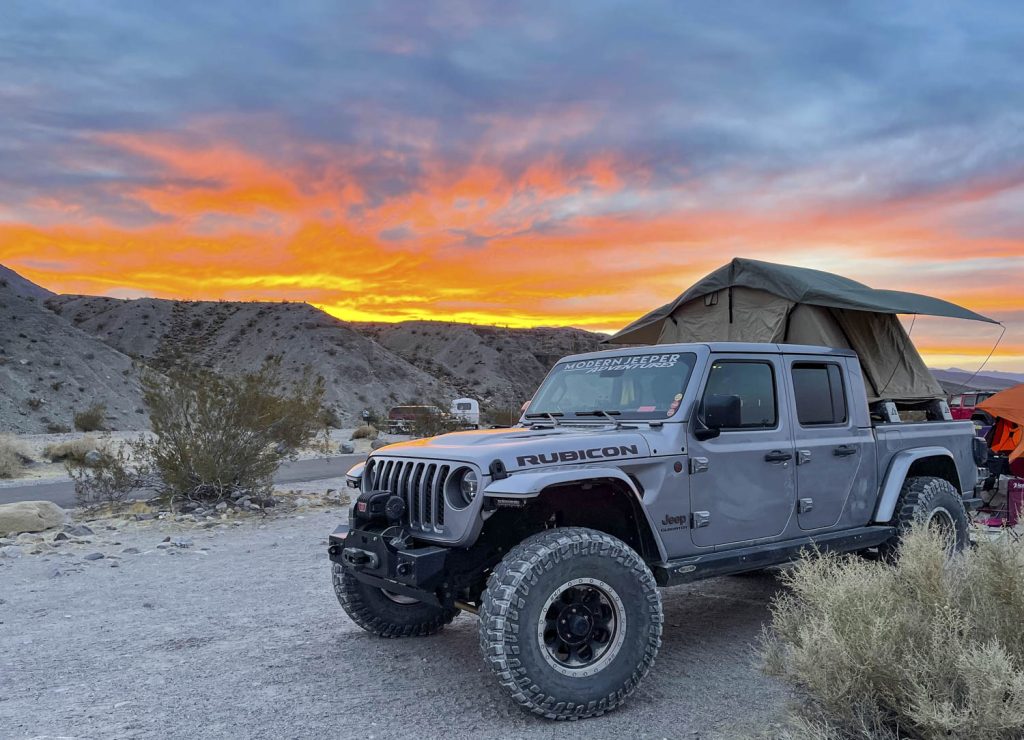Uncategorized
Modern Jeepers Adventures: Death Valley Edition
Story by Jessy Greenland
Photos by Jessy Greenland and Corey Osborne
When you think of a desert, you think, a flat wasteland of hot lifeless death, right? But what of the history it holds or the stories it possesses? It’s probably the last place anyone wants to explore or visit.
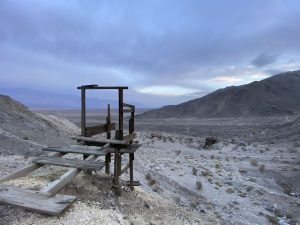 Now that we are back from Death Valley, let me tell you how wrong these things are. Believe me, I’ve seen my share of pictures of Death Valley, and I still had a different outlook on it, to begin with. Boy, it really opened my eyes. Everything I expected or envisioned was thrown out the window! Even pictures and videos did no justice to the amazing things I experienced!
Now that we are back from Death Valley, let me tell you how wrong these things are. Believe me, I’ve seen my share of pictures of Death Valley, and I still had a different outlook on it, to begin with. Boy, it really opened my eyes. Everything I expected or envisioned was thrown out the window! Even pictures and videos did no justice to the amazing things I experienced!
Death Valley is the hottest, driest, and lowest National Park with its below-sea-level basin, steady drought, and record summer heat. Each extreme has the most striking contrast, snow-capped peaks from winter snow, fields of wildflowers from rare rainstorms, magical hidden locations teeming with wildlife and fish; despite the harsh name, there is a great diversity of life. Part of the Mojave desert in Eastern California and the hottest place on earth, Death Valley, was named in 1849 during the California Gold Rush. In 1933, it was proclaimed Death Valley National Monument by President Herbert Hoover, placing it under federal protection. In 1994, the monument was redesignated as Death Valley National Park.
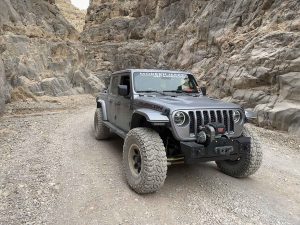 Modern Jeeper Adventures’ first trip to Death Valley was in 2019 and continues to be the prime overlanding destination for Jeepers and anyone wanting to explore this vast landscape. Death Valley is full of stories, history, and amazing diversity in nature with geological wonders. You can go from the lowest sea level at Badwater in Death Valley National Park to the highest point in the contiguous United States at Mt. Whitney in just 85 miles.
Modern Jeeper Adventures’ first trip to Death Valley was in 2019 and continues to be the prime overlanding destination for Jeepers and anyone wanting to explore this vast landscape. Death Valley is full of stories, history, and amazing diversity in nature with geological wonders. You can go from the lowest sea level at Badwater in Death Valley National Park to the highest point in the contiguous United States at Mt. Whitney in just 85 miles.
For this year’s journey, we started in Beatty, Nevada. Beatty is full of interesting characters and history; after spending a couple of days there pre-running this year’s event, we quickly realized we could spend our entire three days here exploring the area surrounding this historical place. Because of a renewed interest in mining, Beatty is full of new mining activity. Wild burros lace the town’s interior and exterior. With only a couple of hotels and a handful of places to stay, you can’t help but meet a few of the characters in Beatty. The short distance from the Dollar Bill/ Motorsports bar to the casino on the far end of town shows there is a little something for everyone in Beatty.
The first day of our adventure began with an amazing breakfast at the corner cafe, where 12 of us filled up the entire small cafe. With our tummies full and a quick drivers meeting, we made our way towards the Mayflower mining district. The wonderment of the forgotten mining areas, jaw-dropping views, scattered dilapidated mining equipment, and buildings left behind in a once-thriving mining community made for some interesting history and hiking through the remaining structures. We had to remind ourselves that we were only a few hours into our first day, and we had a lot more to explore.
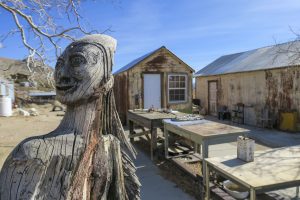 Rhyolite is a ghost town right outside of Beatty with a lot of unique art, a house made of glass bottles, and an old train station. The beauty and eeriness of the statues are something to sit and ponder while sitting on the mosaic couch. At this point, we got ready to go up Titus Canyon Road. This drive is what we call a 5-40. You either go 5 mph or 40 mph; it’s a badly washboarded road that will shake everything loose on your vehicle and make your shocks work overtime. As you come up to the many switchbacks of the Red Pass, which is the highest point of Titus Canyon Road, you are rewarded with a spectacular view of colors and a deep scenic canyon overlooking Leadfield mining. There is an interesting story about how Leadfield mining came about; just like a used car salesman pitch, it was far-fetched, and people still fell for it. Short and simple, you put out a “flyer” for traveling up-river to a big ol’ awesome lie; it’s quite fascinating what people did back then for money.
Rhyolite is a ghost town right outside of Beatty with a lot of unique art, a house made of glass bottles, and an old train station. The beauty and eeriness of the statues are something to sit and ponder while sitting on the mosaic couch. At this point, we got ready to go up Titus Canyon Road. This drive is what we call a 5-40. You either go 5 mph or 40 mph; it’s a badly washboarded road that will shake everything loose on your vehicle and make your shocks work overtime. As you come up to the many switchbacks of the Red Pass, which is the highest point of Titus Canyon Road, you are rewarded with a spectacular view of colors and a deep scenic canyon overlooking Leadfield mining. There is an interesting story about how Leadfield mining came about; just like a used car salesman pitch, it was far-fetched, and people still fell for it. Short and simple, you put out a “flyer” for traveling up-river to a big ol’ awesome lie; it’s quite fascinating what people did back then for money.
On to Titus Canyon, it is a very deep and narrow canyon at the very end of the road. The middle opens up like a riverbed of sorts; I wouldn’t want to be caught in a flash flood down there! The canyon road is beautiful limestone, petroglyphs, native plants, and wildlife. Watch out for the bighorn sheep! You feel like you are going to get swallowed up by the very steep canyon walls that are over half a billion years old; remember to look up! The end of the canyon opens up to the beautiful graben desert floor and giant mountains of the Panamint range. Be on the lookout for hikers in this narrow part of the canyon. At the end is a parking lot and bathrooms to air up or take a break after the three-hour drive through this beautiful canyon.
At this point in the long day, we set sights on our camping spot for the evening in Mesquite Springs, which is 22 miles on pavement. As we set up in our spots and made dinner, we relaxed by the campfire to reflect on the day, as well as take pictures of the beautiful sunset and listen to howling coyotes. Time to sleep for the next long day of another long 5-40 road called the “racetrack” road.
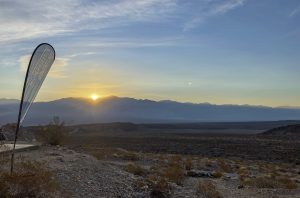 The sun wakes us up bright and early to the smell of bacon that is already cooking over the camp stove. We have a good routine of packing up and heading out for our first stop a few miles down the pavement to the cool cinder cone or the Ubehebe Crater. A powerful volcanic steam explosion created the crater; it is 600 ft deep and half a mile across. We take our pictures and a moment to tell our group about the crater and move on to the racetrack, airing down to make it a better ride, getting ready for a long rough drive of winding, tight corners around hills and a field of Joshua trees.
The sun wakes us up bright and early to the smell of bacon that is already cooking over the camp stove. We have a good routine of packing up and heading out for our first stop a few miles down the pavement to the cool cinder cone or the Ubehebe Crater. A powerful volcanic steam explosion created the crater; it is 600 ft deep and half a mile across. We take our pictures and a moment to tell our group about the crater and move on to the racetrack, airing down to make it a better ride, getting ready for a long rough drive of winding, tight corners around hills and a field of Joshua trees.
We make our way to TeaKettle junction to deposit our signed teakettle at the “offering spot” and move on – many more miles to the “Racetrack Playa.” The playa is magical, and rocks move on the playa and leave a trail. We walk around enjoying the sun and eat our lunch before we head out for another day of adventures! I could write a book about all the amazing parts of Death Valley, but I will end our journey here. Who knows, maybe there will be a part 2? Modern Jeeper Adventures should be on your list to explore and share the Jeeping passion!

